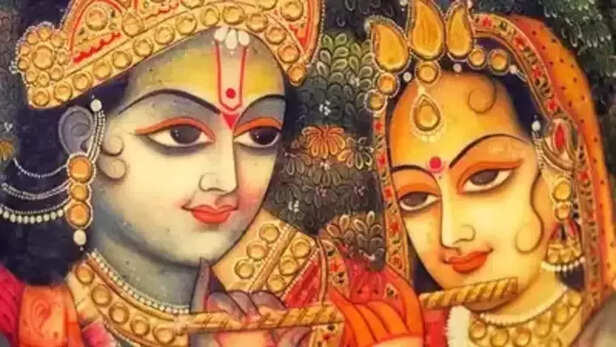Why We Fall for the Wrong People (Again and Again) — The Gita Has an Answer
Nidhi | Apr 11, 2025, 21:30 IST
Mahabharata
( Image credit : Times Life Bureau )
Why do we keep falling for the wrong people, even when we know better? This article explores the emotional and psychological patterns behind repetitive, unfulfilling relationships—and how ancient wisdom from the Bhagavad Gita can help us break the cycle. Drawing from spiritual insights, it explains how attachment (moha), illusion (maya), and lack of self-awareness influence our choices in love. Through the lens of the Gita, readers are guided to understand the difference between true love and emotional dependency, helping them move from confusion to clarity, and from suffering to self-realization.
Why do we keep falling for people who break us beautifully?
It starts the same way every time—a spark, a smile, a thrill we mistake for fate. They feel like home... until they don’t. One moment you're floating in promises, the next you're unraveling quietly, wondering how someone you once dreamed of became a mirror to everything you're trying to heal.
We swear we’ll be wiser next time. We make checklists. We analyze red flags. But the heart, it has its own memory. And before we know it, we’re back—repeating the same pattern with a different name.
So what’s going on here? Is our love flawed? Or is it our idea of love that needs rethinking?
Here’s a surprising answer: The Bhagavad Gita—that ancient dialogue set on a battlefield, between a hesitant warrior and the divine—has quietly been whispering the truth about our relationships all along. Because love, like war, demands clarity. And sometimes, it’s not the people we choose—but the illusions we refuse to let go of—that hurt us most.

When we constantly dwell on what pleases our senses—be it someone's looks, charm, or emotional support—we form attachments. This attachment gives birth to desire, and when that desire is obstructed or unfulfilled, it turns into frustration or anger. The Gita reminds us that the root of our emotional suffering is moha (delusion), caused by over-identification with fleeting attractions. This makes us blind to red flags and glorify the person we are drawn to. We don't fall for the wrong people by accident—we're pulled in by our own mental projections.

We often look to romantic partners to "complete" us or make us feel secure and worthy. But the Gita advises becoming like the ocean—full, unmoved, and inwardly complete. When our sense of self-worth depends on someone else's presence or approval, we lose inner balance. This emotional dependence makes us tolerate unhealthy behavior, idealize unavailable partners, and fear solitude. True peace comes not from craving more love, but from realizing our own capacity to be whole—regardless of external validation.

Many of us confuse intense emotional ups and downs for "passionate love" or fate-driven connection. But real spiritual maturity, according to the Gita, is about samatvam—equanimity in both joy and sorrow. When we are addicted to emotional extremes, we attract chaos and instability. The wrong partners feel "right" because they trigger familiar emotional patterns, not because they align with our higher self. A spiritually evolved heart doesn't seek turbulence; it rests in steady, quiet knowing. And such love doesn’t burn—it heals.

In relationships, our ego desires control, outcomes, and assurances. We want to know how the other feels, when they’ll commit, or how they’ll respond. The Gita emphasizes the importance of acting with sincerity, but releasing attachment to results. When we love from the ego, we become possessive, anxious, and reactive. When we love from the soul, we focus on giving, not clinging. Ego seeks to possess; the soul flows freely. This distinction defines whether a relationship becomes bondage or liberation.

Why do the same types of relationships show up, just in different forms? According to the Gita, the mind is both our greatest friend and worst enemy. If it remains undisciplined and unresolved, it pulls us into familiar karmic loops. We unconsciously recreate patterns rooted in unhealed wounds, childhood attachments, or past-life impressions (sanskaras). Healing begins when we take responsibility for our internal state rather than blaming external partners. The path forward is adhyatma—raising consciousness and making the mind our ally.

The Gita distinguishes between sattvic (pure), rajasic (passionate), and tamasic (ignorant) pleasures. Many relationships start with a rajasic rush—excitement, attraction, intensity—but lack grounding. This initial high is like poison that eventually turns bitter. In contrast, sattvic love might seem slow or even boring at first, but it matures into something deeply nourishing and peaceful. The wrong people often appeal to our restless senses, while the right ones resonate with our higher self. Recognizing this requires stillness and spiritual clarity.
The Bhagavad Gita teaches us that real love is not about losing ourselves in another person—it’s about discovering the Self (Atman) through the experience of love. When we chase the wrong people, we’re often chasing parts of ourselves we haven't yet healed.
To stop repeating painful relationship cycles, we must shift from emotional hunger to inner awareness. From seeking love to becoming love.
Let the Gita be your guide not just in relationships, but in evolving into someone who no longer settles for what wounds, but only welcomes what uplifts.
It starts the same way every time—a spark, a smile, a thrill we mistake for fate. They feel like home... until they don’t. One moment you're floating in promises, the next you're unraveling quietly, wondering how someone you once dreamed of became a mirror to everything you're trying to heal.
We swear we’ll be wiser next time. We make checklists. We analyze red flags. But the heart, it has its own memory. And before we know it, we’re back—repeating the same pattern with a different name.
So what’s going on here? Is our love flawed? Or is it our idea of love that needs rethinking?
Here’s a surprising answer: The Bhagavad Gita—that ancient dialogue set on a battlefield, between a hesitant warrior and the divine—has quietly been whispering the truth about our relationships all along. Because love, like war, demands clarity. And sometimes, it’s not the people we choose—but the illusions we refuse to let go of—that hurt us most.
1. Desire and Attachment Blur Our Inner Vision

Attachment
( Image credit : Freepik )
When we constantly dwell on what pleases our senses—be it someone's looks, charm, or emotional support—we form attachments. This attachment gives birth to desire, and when that desire is obstructed or unfulfilled, it turns into frustration or anger. The Gita reminds us that the root of our emotional suffering is moha (delusion), caused by over-identification with fleeting attractions. This makes us blind to red flags and glorify the person we are drawn to. We don't fall for the wrong people by accident—we're pulled in by our own mental projections.
2. Seeking Wholeness in Others Creates Emotional Dependence

No Toxicity
( Image credit : Pexels )
We often look to romantic partners to "complete" us or make us feel secure and worthy. But the Gita advises becoming like the ocean—full, unmoved, and inwardly complete. When our sense of self-worth depends on someone else's presence or approval, we lose inner balance. This emotional dependence makes us tolerate unhealthy behavior, idealize unavailable partners, and fear solitude. True peace comes not from craving more love, but from realizing our own capacity to be whole—regardless of external validation.
3. Mistaking Emotional Highs for Divine Connection

Sad Girl
( Image credit : Freepik )
Many of us confuse intense emotional ups and downs for "passionate love" or fate-driven connection. But real spiritual maturity, according to the Gita, is about samatvam—equanimity in both joy and sorrow. When we are addicted to emotional extremes, we attract chaos and instability. The wrong partners feel "right" because they trigger familiar emotional patterns, not because they align with our higher self. A spiritually evolved heart doesn't seek turbulence; it rests in steady, quiet knowing. And such love doesn’t burn—it heals.
4. Ego Controls, While the Soul Surrenders

Soul
( Image credit : Pexels )
In relationships, our ego desires control, outcomes, and assurances. We want to know how the other feels, when they’ll commit, or how they’ll respond. The Gita emphasizes the importance of acting with sincerity, but releasing attachment to results. When we love from the ego, we become possessive, anxious, and reactive. When we love from the soul, we focus on giving, not clinging. Ego seeks to possess; the soul flows freely. This distinction defines whether a relationship becomes bondage or liberation.
5. Repeating Painful Patterns is a Karmic Reflection

Radha Krishna
( Image credit : Times Life Bureau )
Why do the same types of relationships show up, just in different forms? According to the Gita, the mind is both our greatest friend and worst enemy. If it remains undisciplined and unresolved, it pulls us into familiar karmic loops. We unconsciously recreate patterns rooted in unhealed wounds, childhood attachments, or past-life impressions (sanskaras). Healing begins when we take responsibility for our internal state rather than blaming external partners. The path forward is adhyatma—raising consciousness and making the mind our ally.
6. Short-Term Pleasure Often Leads to Long-Term Pain

Yuzi and Dhanashree
( Image credit : Times Life Bureau )
The Gita distinguishes between sattvic (pure), rajasic (passionate), and tamasic (ignorant) pleasures. Many relationships start with a rajasic rush—excitement, attraction, intensity—but lack grounding. This initial high is like poison that eventually turns bitter. In contrast, sattvic love might seem slow or even boring at first, but it matures into something deeply nourishing and peaceful. The wrong people often appeal to our restless senses, while the right ones resonate with our higher self. Recognizing this requires stillness and spiritual clarity.
Love Without Awareness is Bondage—With Awareness, It's Liberation
To stop repeating painful relationship cycles, we must shift from emotional hunger to inner awareness. From seeking love to becoming love.
Let the Gita be your guide not just in relationships, but in evolving into someone who no longer settles for what wounds, but only welcomes what uplifts.
